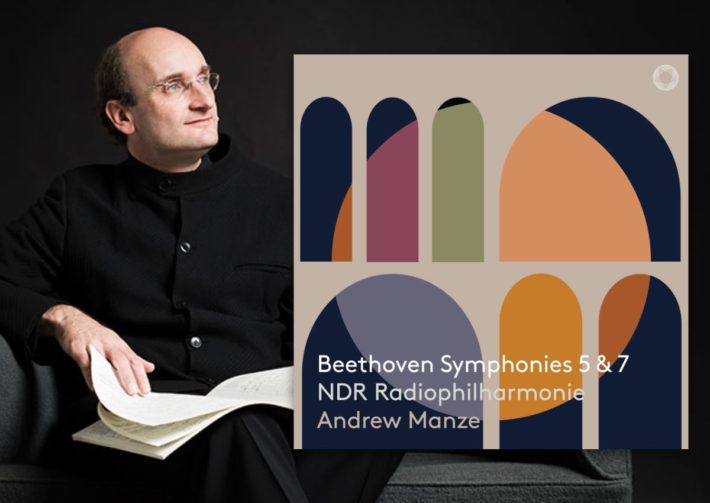Image: ©️ Benjamin Ealoveha
Andrew Manze and the NDR, who recently extended their partnership through 2023, have released a splendid new album of Beethoven’s symphonies 5 and 7. Their approach feels natural, like a wonderful homecoming for these overworked pieces of music. Manze trained as a period instrumentalist, but here he leads a modern ensemble. These considerations inform each other and make this recording especially enjoyable.
Manze and the NDR capture the Seventh Symphony’s endless rhythm, vitality, and rich contrasts with convincing musical choices. The introductory Poco Sostenuto rests around a luxurious 64 bpm, the scales driving but majestic. The delicate phrasing in the winds provides a legato alternative (1’30”). The tempo for the rest of the movement is a true Vivace, and the ensemble playing is tight and precise. The orchestral style is reminiscent of Ádám Fischer’s approach with the Danish Chamber Orchestra, which is impressive given Manze’s larger ensemble. Both use the historically-informed practice of non-vibrato strings and short, simple phrasing. However, Manze takes a more traditional approach, while Fischer strays often from the beaten path, with extreme staccatos and unusual tempo fluctuations. Nothing lacks for vitality in either recording.
In the seemingly immemorial journey to perfect the Allegretto, Manze has come closer than anyone has in a while. He initially rests around 62 bpm, slower than all his contemporaries (Fischer, but also Gardiner and Harnoncourt), though he does speed up where appropriate, as in the fugue. The main theme is played quite staccato, but not without exquisite impulse and structure to the phrases. Throughout, the underlying pulse is incredibly strong, providing a particularly wonderful continuity of phrase in the movement’s coda. I find this combination — slow tempo, staccato, and strong pulse — to be a revelation. In Manze’s hands, this movement is about the contrast between space and silence, and lush / thick colors, not just the contrast between minor and major.
After a scherzo which includes thew repeats, the Finale arrives with gusto: now Manze outpaces his counterparts, easily reaching 158 bpm (Gardiner starts at 152, Fischer 148). NDR can’t quite sustain this tempo, but they do return to it at times, even reaching 162 in the final bars. The strings front-load their sound, giving it a sharpness, again reminiscent of period-practice, but the sustain of modern instruments allows them to sing in longer phrases as well.
Related Classical Music Reviews
- Review: Beethoven – Complete Symphonies – Vienna Philharmonic Orchestra – Nelsons
- Review: Beethoven – Symphony No. 9 – Masaaki Suzuki
- Review: Schumann – Symphonies No. 2 and 4 – LSO, Gardiner
NDR’s tutti tone in the final two movements is not as loud or boisterous as that of many similarly sized groups, but it doesn’t lack any punch. If anything, the pared-down tone helps the rhythms come out of the texture even more. This is almost certainly a period-practice-influenced decision from Manze, and it works to their advantage. There’s nothing contrived here, no nagging doubts, and it’s exciting — a fantastic Seventh all around.
Refreshingly Straightforward
Manze’s approach to the Fifth is similar: the strong sense of pulse and use of space, sharp but full strings, and precise wind playing are all present. The focus on staccato and tight ensemble playing highlight the rhythmic counterpoint of the first movement in a refreshingly straightforward way. There is no creative tempo management as with Fischer. In the Andante, vibrato continues to be noticeably absent. The simplice attitude allows the layered melodies and octaves to shine through in unusual clarity. Even Gardiner and Harnoncourt can’t resist requesting some shimmer from their celli.
The Scherzo pulses along confidently, reveals nothing groundbreaking but sets up a spectacular finale. Rarely are the opening bars of the finale been so pristine and triumphant. Once again, the focus is on the pulse, a wholly appropriate choice. Yet the music at times feels like Brahms (0’49” or 8’12”), with a relaxed tempo and legato solo lines. It’s uncommon that groups can be so at ease playing Beethoven, and yet sound so sophisticated. For connoisseurs of this symphony looking for the next great interpretation, this take may be too conservative, but as a work of art, it works beautifully.
The recording quality of this disc is very high. One hears the orchestra as if in a large hall, the decay of short tutti strikes, or the boom of the timpani. But one also hears the details in the wind playing without being struck by the disorienting feeling of hovering directly above the section. The orchestral sound has real texture, pillow-soft or rock-hard. At moments, the bass booms a bit, but it’s a small quibble. The liner notes are well-written and will be interesting to both seasoned and new listeners.
This album would be a great introduction to Beethoven for newcomers, and will soothe some long-time lovers’ aches for a breath of fresh air. I’m very much looking forward to Manze and NDR’s future projects.

Beethoven – Symphonies No. 5 and 7
NDR Radiophilharmonie
Andrew Manze – Conductor
Pentatone, Hybryd SACD, PTC 5186814
Albums Mentioned In This Review
Read more classical music reviews or visit The Classic Review Amazon store
Follow Us and Comment:
Get our periodic classical music newsletter with our recent reviews, news and beginners guides.
We respect your privacy.









